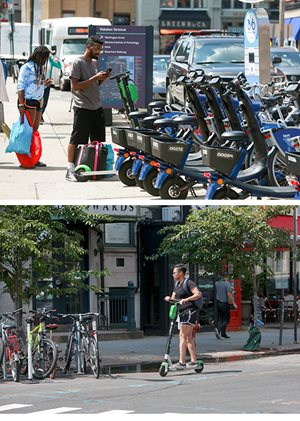 Micromobility is poised to become the “the next chapter in the transportation mobility future” Shabazz Stuart, Founder and CEO of the company Oonee, told the NJTPA Board at its November 8 meeting.
Micromobility is poised to become the “the next chapter in the transportation mobility future” Shabazz Stuart, Founder and CEO of the company Oonee, told the NJTPA Board at its November 8 meeting.
Encompassing a wide range of devices that travel under 30 miles an hour—including bikes, scooters, skateboards, unicycles, e-bikes and even wheelchairs—Stuart said micromobility is “the fastest growing segment of transportation in America.” The growth has been made possible by towns and cities around the country installing bike lanes and other infrastructure, creating new plans and policies for use of streets and supporting bike share, scooter share and other services.
Stuart’s company works with local governments to create modular infrastructure that gives micromobility riders parking, charging, and servicing. Oonee has installed enclosed modules on residential streets and larger parking stations at central locations in Jersey City and New York City. The company has plans for continued expansion based on data and outreach on community needs.
Stuart said many people think that micromobility is mainly used for recreation or by young people. However, he said, as its popularity has grown—particularly during the pandemic—micromobility is now being recognized as an “important mode of public transportation” for commuting and daily trips.
Biking and other means of micromobility are particularly suited to the shortest trips, he said, noting that 50 percent of trips are under three miles and 20 percent of trips are a mile or less. Even converting a share of these trips to micromobility he said could help cities and towns operate more efficiently, reducing traffic congestion and improving access to transit stations from wider areas.
Public support for micromobility also enhances equity, he said, because a large share of users are low income or immigrants. Those with incomes less than $35,000 per year are 10 times more likely to bike than others, Stuart said. As micromobility continues to grow, “we’re going to have dividends across the playing field,” he said.
While safety must be improved to support micromobility’s growth, there also must be efforts to provide parking and service opportunities, a sustainable economic model for operators and comprehensive planning, he said. The economics can be particularly difficult, he said, because like public transit, micromobility requires public investments and some measure of subsidy, rather than relying on venture capital investments.
NJTPA Chair Kathy DeFillippo commended Stuart for the presentation, which she said provided “food for thought” for the NJTPA and the region’s municipalities.
Click here to view the presentation.